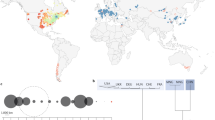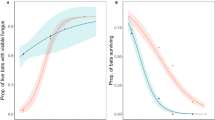Abstract
White-nose syndrome (WNS) has caused recent catastrophic declines among multiple species of bats in eastern North America1,2. The disease’s name derives from a visually apparent white growth of the newly discovered fungus Geomyces destructans on the skin (including the muzzle) of hibernating bats1,3. Colonization of skin by this fungus is associated with characteristic cutaneous lesions that are the only consistent pathological finding related to WNS4. However, the role of G. destructans in WNS remains controversial because evidence to implicate the fungus as the primary cause of this disease is lacking. The debate is fuelled, in part, by the assumption that fungal infections in mammals are most commonly associated with immune system dysfunction5,6,7. Additionally, the recent discovery that G. destructans commonly colonizes the skin of bats of Europe, where no unusual bat mortality events have been reported8,9,10, has generated further speculation that the fungus is an opportunistic pathogen and that other unidentified factors are the primary cause of WNS11,12. Here we demonstrate that exposure of healthy little brown bats (Myotis lucifugus) to pure cultures of G. destructans causes WNS. Live G. destructans was subsequently cultured from diseased bats, successfully fulfilling established criteria for the determination of G. destructans as a primary pathogen13. We also confirmed that WNS can be transmitted from infected bats to healthy bats through direct contact. Our results provide the first direct evidence that G. destructans is the causal agent of WNS and that the recent emergence of WNS in North America may represent translocation of the fungus to a region with a naive population of animals8. Demonstration of causality is an instrumental step in elucidating the pathogenesis14 and epidemiology15 of WNS and in guiding management actions to preserve bat populations against the novel threat posed by this devastating infectious disease.
This is a preview of subscription content, access via your institution
Access options
Subscribe to this journal
Receive 51 print issues and online access
$199.00 per year
only $3.90 per issue
Buy this article
- Purchase on Springer Link
- Instant access to full article PDF
Prices may be subject to local taxes which are calculated during checkout


Similar content being viewed by others
References
Blehert, D. S. et al. Bat white-nose syndrome: an emerging fungal pathogen? Science 323, 227 (2009)
Turner, G. G., Reeder, D. M. & Coleman, J. T. H. A five-year assessment of mortality and geographic spread of white-nose syndrome in North American bats and a look to the future. Bat Res. News 52, 13–27 (2011)
Gargas, A., Trest, M. T., Christensen, M., Volk, T. J. & Blehert, D. S. Geomyces destructans sp. nov. associated with bat white-nose syndrome. Mycotaxon 108, 147–154 (2009)
Meteyer, C. U. et al. Histopathologic criteria to confirm white-nose syndrome in bats. J. Vet. Diagn. Invest. 21, 411–414 (2009)
Casadevall, A. Fungal virulence, vertebrate endothermy, and dinosaur extinction: is there a connection? Fungal Genet. Biol. 42, 98–106 (2005)
Blanco, J. L. & Garcia, M. E. Immune response to fungal infections. Vet. Immunol. Immunopathol. 125, 47–70 (2008)
Maschmeyer, G., Calandra, T., Singh, N., Wiley, J. & Perfect, J. Invasive mould infections: a multi-disciplinary update. Med. Mycol. 47, 571–583 (2009)
Wibbelt, G. et al. White-nose syndrome fungus (Geomyces destructans) in bats, Europe. Emerg. Infect. Dis. 16, 1237–1242 (2010)
Martínková, N. et al. Increasing incidence of Geomyces destructans fungus in bats from the Czech Republic and Slovakia. PLoS ONE 5, e13853 (2010)
Puechmaille, S. J. et al. Pan-European distribution of white-nose syndrome fungus (Geomyces destructans) not associated with mass mortality. PLoS ONE 6, e19167 (2011)
Turner, G. G. & Reeder, D. M. Update of white-nose syndrome in bats, September 2009. Bat Res. News 50, 47–53 (2009)
Puechmaille, S. J. et al. White-nose syndrome fungus (Geomyces destructans) in bat, France. Emerg. Infect. Dis. 16, 290–293 (2010)
Koch, R. Die aetiologie der tuberkulose. Mitt. Kaiser. Gesundh. 2, 1–88 (1884)
Cryan, P. M., Meteyer, C. U., Boyles, J. G. & Blehert, D. S. Wing pathology of white-nose syndrome in bats suggests life-threatening disruption of physiology. BMC Biol. 8, 135 (2010)
Foley, J., Clifford, D., Castle, K., Cryan, P. M. & Ostfeld, R. S. Investigating and managing the rapid emergence of white-nose syndrome, a novel, fatal, infectious disease of hibernating bats. Conserv. Biol. 25, 223–231 (2011)
Thomas, D. W., Fenton, M. B. & Barclay, M. R. Social behavior of the little brown bat, Myotis lucifugus. Behav. Ecol. Sociobiol. 6, 129–136 (1979)
Fenton, M. B. Summer activity of Myotis lucifugus (Chiroptera:Vespertilionidae) at hibernacula in Ontario and Quebec. Can. J. Zool. 47, 597–602 (1969)
Rajkumar, S. S. et al. Clonal genotype of Geomyces destructans among bats with white-nose syndrome, New York, USA. Emerg. Infect. Dis. 17, 1273–1276 (2011)
Desprez-Loustau, M. L. et al. The fungal dimension of biological invasions. Trends Ecol. Evol. 22, 472–480 (2007)
Frick, W. F. et al. An emerging disease causes regional population collapse of a common North American bat species. Science 329, 679–682 (2010)
Skerratt, L. F. et al. Spread of chytridiomycosis has caused the rapid global decline and extinction of frogs. EcoHealth 4, 125–134 (2007)
Lorch, J. M. et al. Rapid polymerase chain reaction diagnosis of white-nose syndrome in bats. J. Vet. Diagn. Invest. 22, 224–230 (2010)
White, T. J., Bruns, T., Lee, S. & Taylor, J. Amplification and direct sequencing of fungal ribosomal RNA genes for phylogenetics. In PCR Protocols: A Guide to Methods and Applications 315–322 (Academic Press, 1990)
Acknowledgements
Financial support for this project was provided by the US Geological Survey, the US Fish and Wildlife Service, Bat Conservation International, and the Indiana State University Center for North American Bat Research and Conservation. Use of trade, product, or firm names is for descriptive purposes only and does not imply endorsement by the US Government. We acknowledge E. Buckles, S. Darling and T. Tomasi for discussions during the development of this project. We thank N. Keller for comments during the preparation of this manuscript. We also thank J. P. White, R. Dusek, A. Klein, L. Leppert, K. Schuler, C. L. White and NWHC Animal Care Staff for their help with set-up and maintenance of animals, and D. Berndt, L. Muller, A. Pike and M. Verant for their assistance during necropsies. We thank X. Yu for help with statistical analyses.
Author information
Authors and Affiliations
Contributions
D.S.B., A.C.H., P.M.C. and D.M.R. designed the study. A.C.H., J.T.H.C. and D.N.R. collected wild animals for the study. J.M.L., D.S.B., C.U.M., M.J.B., J.G.B., A.C.H., A.E.B., J.T.H.C., D.N.R. and D.M.R. performed the experiment and/or assisted to collect samples upon completion. C.U.M. and M.J.B. read and interpreted histopathology. J.M.L. and J.G.B. analysed the experimental data. A.E.B. compiled data on wild bats submitted to the NWHC for diagnostic testing. J.M.L. wrote the manuscript and all co-authors provided input. D.S.B. supervised data analyses and edited the manuscript.
Corresponding author
Ethics declarations
Competing interests
The authors declare no competing financial interests.
Supplementary information
Supplementary Figures
The file contains Supplementary Figure1 with a legend. (PDF 592 kb)
PowerPoint slides
Rights and permissions
About this article
Cite this article
Lorch, J., Meteyer, C., Behr, M. et al. Experimental infection of bats with Geomyces destructans causes white-nose syndrome. Nature 480, 376–378 (2011). https://doi.org/10.1038/nature10590
Received:
Accepted:
Published:
Issue Date:
DOI: https://doi.org/10.1038/nature10590
This article is cited by
-
Joint Spatial Modeling Bridges the Gap Between Disparate Disease Surveillance and Population Monitoring Efforts Informing Conservation of At-risk Bat Species
Journal of Agricultural, Biological and Environmental Statistics (2024)
-
Higher white-nose syndrome fungal isolate yields from UV-guided wing biopsies compared with skin swabs and optimal culture media
BMC Veterinary Research (2023)
-
Environmental transmission of Pseudogymnoascus destructans to hibernating little brown bats
Scientific Reports (2023)
-
Bioinspired peptides induce different cell death mechanisms against opportunistic yeasts
Probiotics and Antimicrobial Proteins (2023)
-
DNA Metabarcoding Reveals Cryptic Diversity in Forest Soils on the Isolated Brazilian Trindade Island, South Atlantic
Microbial Ecology (2023)
Comments
By submitting a comment you agree to abide by our Terms and Community Guidelines. If you find something abusive or that does not comply with our terms or guidelines please flag it as inappropriate.



